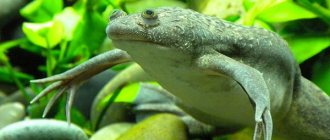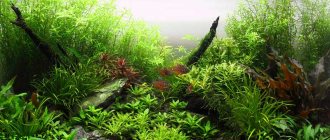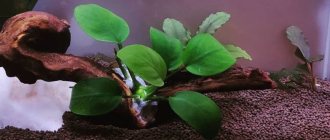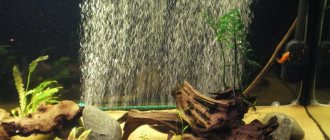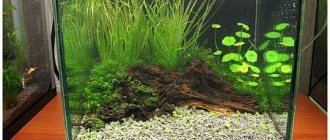Anubias
These plants are common among aquarists due to their low maintenance requirements. Anubias tolerates shade well; for its normal growth there is no need to purchase light sources or organize an additional supply of carbon dioxide.
It has a short, but quite powerful and branched root system. There are dwarf and large species of this plant.
Can be used in an aquarium with such types of aquarium fish as goldfish and cichlids, because Anubias has fairly hard leaves that are too tough for these fish.
List of popular plants in alphabetical order
To make it easier to find undemanding plants for an aquarium, a list of the most popular ones has been compiled.
Anubias Bartera
It has several varieties - dwarf, coffee-leaved, speckled, broad- and narrow-leaved. Plant height – 20 cm, width – 15 cm. Hard leaves allow Anubias to be bred in aquariums with aggressive fish, such as cichlids.
The dwarf variety anubias nana is small in size, which makes it possible to use the plant to decorate a small aquarium.
Water hyacinth
The plant is flowering, so when propagated in a closed aquarium, an air cushion (at least 25 cm) is left above the surface. The flower loves warmth and light. Feels comfortable at +25-30°C and additional lighting.
Hygrophiles
There are about a hundred species used as aquarium thickets. The most common are lemongrass, loosestrife and red. By changing the lighting in the aquarium, you can achieve different shades of plants. Increased lighting leads to the appearance of redness in the foliage. Plants need periodic pruning.
Kabomba
Not suitable for breeding in aquariums with fast inhabitants. Predators tear off the foliage, which leads to the death of beautiful lush bushes.
Krinum
It is used for large aquariums, as it can stretch up to half a meter in length. Cool water causes the leaves to yellow, so the temperature in the aquarium is maintained at least +23°C. Peat or gravel soil is used for rooting.
Limnobium
Algae that does not have a root system is suitable for decorating the surface of the water surface. Limnobium periodically requires thinning, since in comfortable conditions it covers the entire surface.
Ludwigia repens
The plant can be used for planting in the ground, or left to decorate the surface of the reservoir. The leaf blades have a greenish-red tint, and in good lighting they become bright and expressive. The water for maintenance must be warm, not lower than +22°C.
Marsilia quatrefoil
Outwardly it resembles a summer clover carpet. Used to decorate the bottom. Undemandingness and good adaptability to conditions are a definite advantage for beginners.
Moss
Moss is used to decorate underwater rocks, bottom or driftwood. For example, moss flame (flame) is an excellent choice for bottom decoration. The vibration of the liquid in the aquarium sets the moss stalks in motion, the picture resembles a fiery flame, only green.
Phoenix - moss that allows you to decorate stones. It grows only under water, attaching itself to decorative elements with rhizoids. Once on the surface, it dries out. To temporarily hold moss on stones (before rooting), it is recommended to use rubber bands or fishing line.
Java moss has a beautiful spiky foliage structure. In aquariums it is decorated with decorative elements located on the bottom. It is unpretentious, but requires placement away from feeders, as it tends to get dirty quickly.
Riccia
Another type of moss that floats underwater. It grows quite quickly, so it requires periodic pruning. Decorating an underwater hummock or driftwood with moss is very easy. The riccia layer is pressed with a net or elastic bands on the selected decorative element. After 3-4 weeks, Riccia will completely envelop the hummock. To prevent the moss from rotting and floating, it is necessary to trim the plant to 3 cm.
Christmas moss
Reminiscent of New Year's holidays with its needle-like branches. It is best to place dwarf shrimp next to such thickets. They help in keeping the plant clean while using the moss as a feeder and shelter. Fry can also find shelter in moss thickets.
You can use Christmas moss to create a beautiful green tree at the bottom of your aquarium. To do this, you will need a sponge, superglue and a dried branch shaped like a tree. Using scissors, the sponge is cut into thin strips, which are attached to the wood with glue.
A stable stone is used as a base, onto which the tree is fixed. Using tweezers, the moss is divided into small bunches and applied to the sponge. In an aquarium, the moss gradually takes root and begins to branch, transforming a dried stick into a real green tree.
Duckweed
Used to decorate the water surface. The fish will be grateful for natural food in the form of duckweed. Please note that algae creates shading in the aquarium. Duckweed loves bright light and is able to withstand changes in temperature.
It grows very quickly, so control of its quantity is necessary. Shrimp like to hide in duckweed, and the dried leaves of the plant are a source of vitamin-rich food for fish.
Hornwort
There are about three dozen species of this plant. The most common species found in aquariums are submerged, semi-submerged and flat-spined. Immersed differs from other varieties in its massiveness and dark green color.
Hornwort does not need rooting. It is left to float freely or tied to a snag. Basic care involves periodically washing the algae under running water. This will help clean the Christmas tree from food debris and other contaminants. After bathing, the plant is placed back into the aquarium.
Elodea
Refers to perennial plants characterized by rapid growth. It is a natural food for mollies. It can reach a length of two meters, so trimming is indispensable. The plant can be planted in the ground or allowed to float freely.
There are several interesting varieties: Canadian, leafy, jagged. Elodea serves as a natural filter, as its branches absorb harmful substances and attract food debris, purifying the water. Suitable as a background against which plants with enlarged foliage look advantageous.
Echinodorus rose
It is a hybrid deciduous plant that grows no more than 25 cm. Low lighting (0.4 W/l) is suitable for cultivation, but the soil should be silty. The main decoration of the plants is light pink elliptical foliage. It grows slowly and loves warm water.
Ambulia
This is a large plant that forms quite extensive thickets if there is free space in the aquarium. The height can reach one meter, but when kept at home it usually does not exceed 50 cm.
Ambulia is a natural filter that helps clean the aquarium space from various contaminants.
One of the features of this plant is that it lives according to its own specific biological cycle. Every evening, the ambulia falls into a kind of hibernation: its leaves fold, and in the morning the plant straightens out again. However, the lighting level does not affect this process in any way.
Direct planting into the ground is possible due to the well-developed root system. Due to the rather long leaves, it is best to place it in the background of the aquarium so that the plant does not cover the rest of the space.
Vallisneria
To grow this plant, the bottom of the aquarium must be lined with soil 5 mm thick. It has long, ribbon-shaped leaves that move beautifully with the movement of water.
It is not picky about living conditions, but it is better not to plant this plant in aquariums where burrowing fish species live. The leaves should be trimmed periodically so that they do not cover the rest of the aquarium space.
Additional accessories
To create optimal conditions in an aquarium, you will need not only basic knowledge, but also additional equipment. Algae require additional lighting. Without light, plants look unimportant and practically stop growing.
Some require a lot of light, others get by with minimal amounts. Therefore, when purchasing, be sure to ask about all the conditions.
To root the plants, you will need soil, the layer thickness is approximately 8 cm.
Typically, light, fine-grained soil is chosen, in which rooting and development proceed faster.
Cladophora
This is an interesting type of aquarium plant that attracts the eye, first of all, with its spherical shape. In addition, cladophora is a natural biofilter that passes aquarium water through itself, naturally filtering it.
It comes in two types:
- The spherical one is the same natural biological filter that we are talking about. Feels good in both soft and hard water. The only thing you need to closely monitor is the water temperature, which should not exceed 25 degrees (for this reason, cladophora is not the best neighbor for tropical fish).
- Filamentous - this variety does not have any decorative value, representing a plant made of hard long threads. This is an undesirable grass for the aquarium, so you can get rid of it by balancing the internal ecosystem.
The spherical cladophora is not demanding on the level of lighting, but you need to ensure that the aquarium water is sufficiently clean.
Ludwigia
The plant has long leaves and stems that can change color depending on the light intensity. If the light is bright enough, the plant will turn bright red; if there is little light, the shade will be dark green.
The plant grows well in an aquarium with clean filtered water, in soil up to 5 mm thick. There are no other special requirements for content.
What is the difference between plants and algae
Algae appeared on Earth long before higher plants, and therefore have a more primitive structure. Their body (thallus, thallus) is not differentiated into organs (stem, leaves, roots) and tissues.
They reproduce in 3 ways:
- asexual;
- sexual;
- vegetative.
Algae can be unicellular, multicellular and colonial, and plants can only be of the first and second types. Most algae live in water, while the bulk of plants live on land and only a small part live in water or at the boundaries of environments.
Riccia
Riccia is a rich green moss. It consists of flat plates that are loosely intertwined with each other. The plant has no stems or leaves, i.e. organs familiar to the plant. Under favorable conditions, it can form quite large floating islands of vegetation.
The plant is not picky about its conditions. The optimal temperature is from 22 to 29 degrees. The water should be pH neutral and not very hard. The main point is the level of lighting, which should be bright enough. If there is not enough light, the plant will begin to disintegrate into separate parts.
There are several options for using Riccia:
- To cover the soil in the foreground of the aquarium.
- To create diffused light if other aquarium plants require it.
- As a feed for cichlids.
- Can be used in spawning aquariums (to cover fry).
Echinodorus
Echinodorus is a perennial marsh grass; some species can also grow on land. The absence of a stem is the main feature of all species of Echinodorus, even large representatives.
The leaves of the plant appear directly from the rhizome, from which thickenings (rhisomes) grow, on which buds then grow. The usual method of reproduction is budding.
The leaves of Echinodorus are very elongated and very dense. The shape of the leaves is spear-shaped, pointed or oval on top, and also elliptical.
Echinodorus is a flowering algae; a long peduncle ending in an inflorescence grows directly from the leaves. Branches may form on the peduncle and leaves may grow. Roots are already growing from them, and the daughter plant is separated from the mother plant. This is also a characteristic method of propagation of Echinodorus along with the root.
Echinodorus are usually kept in deep aquariums, since their height can reach 60 cm. Grass is planted in the center of the aquarium closer to the back side.
Coarse sand or fine gravel is used as soil. It would also be a good idea to add river silt to the soil. The ideal temperature would be 18-26 degrees Celsius, water hardness - 5-10 mEq/l. The acid balance should be neutral. Such conditions are suitable for most decorative species, although there are particularities for certain species.
Different species and hybrids of Echinodorus are being created to this day. Next you can see the names of the species and varieties of these algae with pictures:
- Echinodorus angustifolia;
- Echinodorus cordifolia Tropica Marble Queen;
- Echinodorus tender;
- Echinodorus osiris;
- Echinodorus Blecher, or yarrow;
- Echinodorus rubin;
- Echinodorus Kleiner Bar;
- Echinodorus rose;
- Echinodorus osiris doppel mouth;
- Echinodorus Jungelstar;
- Echinodorus Amazonis.
Hornwort
The plant has long stems with needle-shaped leaves. The algae clings to the soil and has no root system. In its natural environment, it grows at a depth of up to nine meters, so the plant is not picky about its conditions.
Here are some features of this plant:
- It is a natural biofilter, so it needs to be cleaned periodically.
- Used to create biological balance (suitable for starting an aquarium).
- Tolerates water of high acidity and hardness well.
- Does not require additional carbon dioxide supply or fertilizing.
- Not picky about temperature (keep at normal room temperature is sufficient) and lighting.
It does not have a root system, so the plant is not planted in the ground. As a rule, it is tied with fishing line to a stone or aquarium decor.
Recommendations for planting
Purchased plants are carefully inspected before planting. If the roots show signs of rotting or damage, such places are trimmed with a sharp knife or scissors. Leaves with yellowed areas are also removed.
In plants with a weak root system, the roots are not thinned.
If the roots are too developed, they are partially trimmed, leaving a length of no more than 2-3 cm.
Stems that are too long are also shortened, leaving several nodes.
The algae, sorted and cleared of excess roots and leaves, are washed in a basin of warm water.
Duckweed
It is one of the most unpretentious plants for an aquarium. The only requirement is to exclude too bright light. At the same time, there are a number of polar opinions among aquarists about this algae: some consider it useless, and in some cases harmful, while others believe that it brings its own benefits. The second position is supported by the following arguments:
- the plant releases oxygen;
- algae contains iodine and bromine, which helps enrich the water;
- helps in the fight against nitrites and nitrates;
- can be used as food for aquarium inhabitants.
In particular, goldfish love to eat these algae, so duckweed is often grown separately to be added to food (in dried form).
Why is vegetation needed?
Fish in their underwater kingdom can exist quite well without representatives of the flora. But will such an aquarium be alive, and will it be able to provide pleasure from contemplating a piece of nature?
Properly selected plants for the aquarium create an intoxicating magical world behind the glass, which calms and puts you in a good mood. The purpose of a herbalist's aquarium is much more than just a piece of furniture, both for humans and for the inhabitants of the underwater space. Aquarium flora maintains ecological balance in a closed environment, bringing conditions closer to natural phenomena.
- The “lungs” of the aquadome produce oxygen. Provide natural filtration by absorbing calcium.
- They utilize fish waste products and purify the water.
- Through the pores of the leaves, minerals are absorbed, which serve as a source of vitamins for freshwater animals.
- Not receiving enough food, the fish replenish their diet with the help of an underwater garden.
- The natural plant environment is conducive to laying eggs on leaves.
- In secluded places among the thickets, small fish hide from aggressive relatives.
Vegetation in the aqua corner is necessary for the full existence of aquatic inhabitants. Like any living vegetation, aquarium inhabitants require attention, care and certain conditions of maintenance.
Indian fern
Suitable for placement in the foreground of an aquarium due to its openwork leaves and curly stems. Depending on the conditions of detention, the color of the leaves can be light green or deep green, turning into emerald.
The root system is developed, so it can be planted in soft soil. Accordingly, it does not get along with fish species that like to burrow into the ground. Loves fairly bright light, but it must be diffused, because the plant does not tolerate direct light.
Comfortable temperature for growth is about 25-26 degrees. At lower temperatures, the plant does not die, but its growth slows down.
What is needed for active growth
For the active growth of aquatic plants, special fertilizers intended for aquarium flora are used. It is unacceptable to use types of fertilizers for plants in pots.
Pet stores sell different types of fertilizers for aquatic plants. These are tablets and various liquid solutions containing macro- and microelements. Nutrients strengthen roots, improve survival rate after planting, and stimulate active growth and flowering.
In addition to ready-made fertilizers, when planting plants, you can use folk remedies that have been proven over the years. Clay placed in lumps under the root system of the seedling has a good effect on the flora of the aquarium.
Hygrophila
Hygrophila is characterized by rapid growth, as well as unpretentiousness to living conditions. It grows actively throughout the year. It is possible to grow shoots - just plant the cut branch in the ground.
The optimal temperature is from 22 to 27 degrees. There are no special conditions for the lighting level. If the conditions are not ideal, the plant will not die, but will only become less beautiful.
Kabomba
A bush-like plant whose leaves are quite thin (in appearance they resemble pine needles). The plant looks very beautiful in the aquarium space, therefore it is very popular among beginners and experienced aquarists.
The plant can be planted in soft soil. Depending on the variety, cabomba grows actively at temperatures from 23 to 30 degrees. It can grow in hard water, but growth will not be as vigorous.
Sagittaria
The plant is distinguished by bright green leaves that are pointed towards the end. It is not demanding on temperature levels, so it can also be kept in tropical aquariums.
The plant is flowering, but this is only possible if all maintenance rules are followed. Flowering lasts up to 14 days.
Reproduction
The vast majority of aquarium plants reproduce by vegetative methods:
- Cuttings. They are obtained by cutting off branches from the stem or by shortening the main stem. Some species are capable of producing roots without soil, while others are better buried in the substrate.
- Offsprings (layers). The new plant comes from the main rhizome or creeping shoot.
- By shoots. Daughter plants, or otherwise adventitious plants, appear on the maternal part (leaves, inflorescences, roots) from an adventitious bud. As soon as the seedling has formed its strong rhizome, it can be separated.
- Rhizome division.
Seed propagation is extremely rare in underwater plants, since it requires the formation of female and male (or hybrid) inflorescences. But even in this case, self-pollination does not always occur, so you have to do it manually, transferring pollen from the stamens to the flowering stigmas with a brush.
Elodea
The plant is distinguished by its accelerated growth if the maintenance conditions are observed (increased supply of carbon dioxide and high level of light).
Elodea has several features:
- can be used for the first start of an aquarium;
- forms fairly dense thickets of vegetation where fry can hide;
- acts as a natural filter, absorbing substances harmful to aquarium fish from the water;
- releases oxygen (in bright light).
The plant does not like too warm water, so the optimal temperature is considered to be 16-24 degrees. Planting in the ground is not necessary; there are no special requirements for water hardness.
Keep in mind that it displaces some types of other aquarium vegetation, so you need to periodically thin out the plant.
Fontinalis
The plant is a clump of rich green color that can reach a height of 25 cm. These aquarium plants are not exactly suitable for beginners, but we have added them to this list anyway because of their beautiful appearance.
The conditions of detention are as follows:
- Comfortable temperature is from 24 to 28 degrees. But in winter they need rest, so the temperature will need to be reduced to 12-14 degrees, and the lighting intensity will also need to be reduced.
- It grows well only in clean water. To maintain cleanliness, you will have to change up to a quarter of the water in the aquarium every week.
- There must be a good filtration system so that there is no turbidity in the aquarium.
Care
Unpretentious plants require simple care:
- water change;
- pruning overgrown branches;
- removal of rotting and damaged parts;
- application of fertilizers.
Partially change the water and thin the plant once a week. Do not replace large amounts of water unless necessary; it is enough to fill up to 25% of the aquarium volume. Combine fluid changes with soil siphoning. Siphon the soil carefully near the roots, using special small nozzles so as not to damage the plants. Apply fertilizer as needed, no more than once a month. Be careful with dosages.
Typically, unpretentious flora does not require additional fertilizing; green plants are sufficiently nutrient-dense in the water. Monitor the light intensity and color spectrum. When using fluorescent lamps, change them on time.
Java moss
This type of aquarium moss is suitable for beginners as well as more experienced aquarists. This is explained by the fact that it is very unpretentious in care, while it actively grows, regardless of the conditions of detention.
Java moss grows in different directions, resembling the crown of trees from afar. It can be trimmed, which gives a rather interesting decor.
This plant can be used exclusively for decorative purposes, or can be used in spawning aquariums (many fish lay eggs in this plant).
Attaches to any surface (stones, glass), so planting in the ground is not necessary. It loves clean water, so the aquarium must have a good filtration system (the moss itself can be periodically cleaned with a toothbrush to remove dirt).
We have described the most unpretentious aquarium plants, but remember that they all require at least minimal care. As a rule, it comes down to choosing the right lighting and comfortable temperature, but some plants are especially demanding about the purity of the water, so a high-quality filtration system and periodic maintenance of the aquarium are necessary.
Specialists are engaged in creating custom aquariums and servicing them in Moscow, not only solving the task at hand, but also answering all your questions in this area. We replace water in the required quantity, install filter elements, support aquarium design, and also perform other types of work. Possibility of visiting your home or office.
Adviсe
- Plant long-stemmed species in bunches of several pieces, so the vegetation will look more impressive.
- Secure mosses and ferns to driftwood and rocks.
- Beginners who have no experience in using fertilizers use ready-made general-purpose fertilizers.
- When planting bushes, leave a distance of 10 cm between them. It will take some time to fill the gaps.
- Greens brought from natural bodies of water will rot in a warm water reservoir. Before being placed in a community aquarium, the flora must acclimatize for a long time in a separate container. Increase the temperature gradually.
- Rinse the newly acquired vegetation with running water. Disinfect the twigs in a 1% solution of alum diluted in a liter of water for 5–10 minutes.
- Place fast-growing and light-loving plants in the most illuminated part of the vessel.
- For faster flowering of the flora, place it as high as possible. Then it will sooner emerge from the water and bloom.
Aquascaping has long been recognized as an applied art. Unpretentious and diverse plant species allow novice aquarists to get into aquascaping quickly and easily.
Previous
Plants6 types of nymphs for the aquarium
Next
PlantsJavan moss - a decorative ornament from the island of Java

